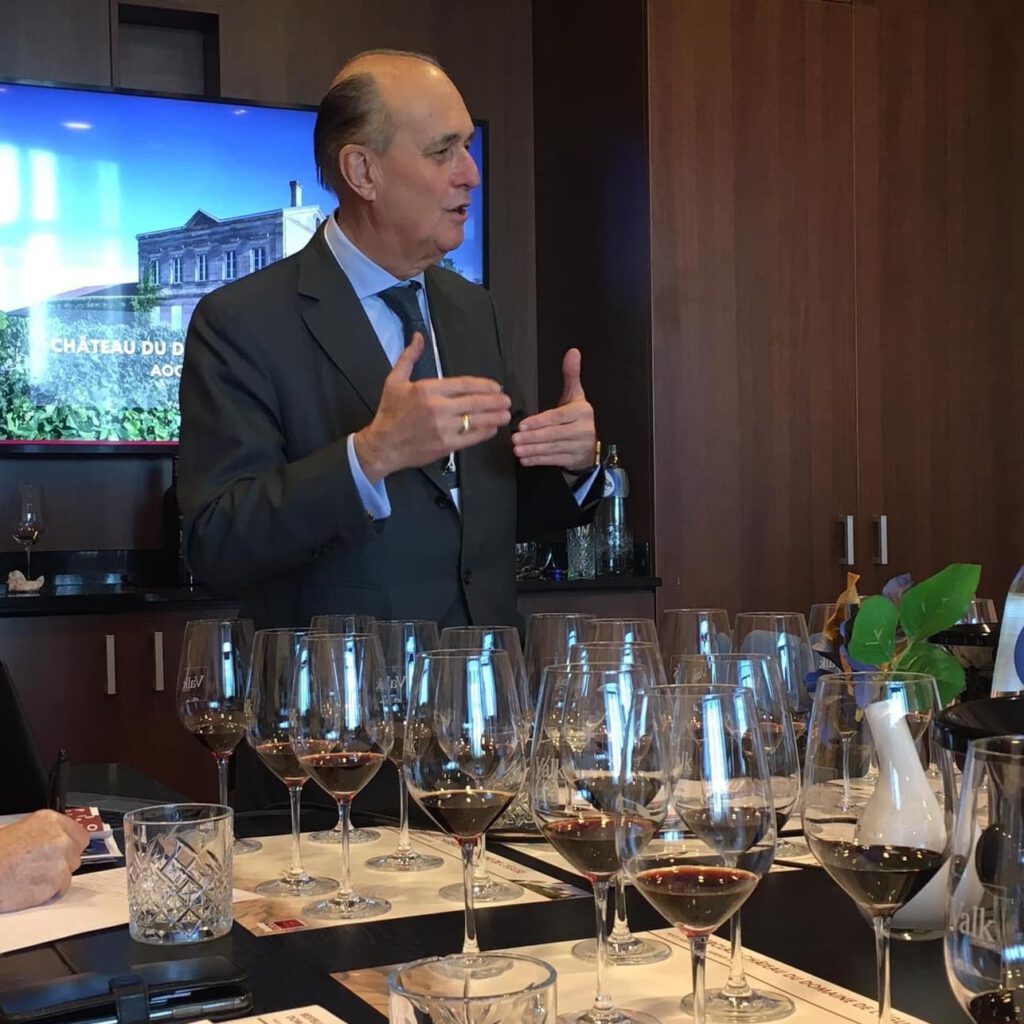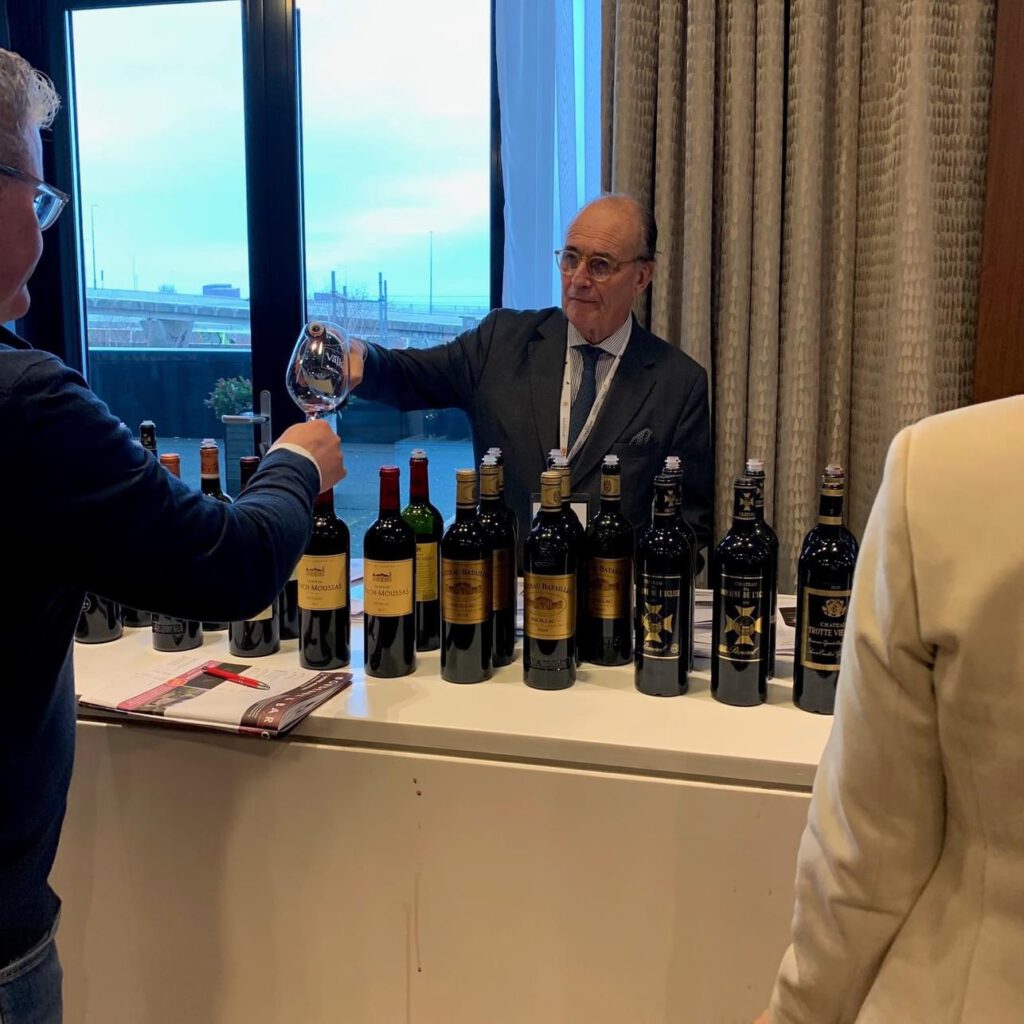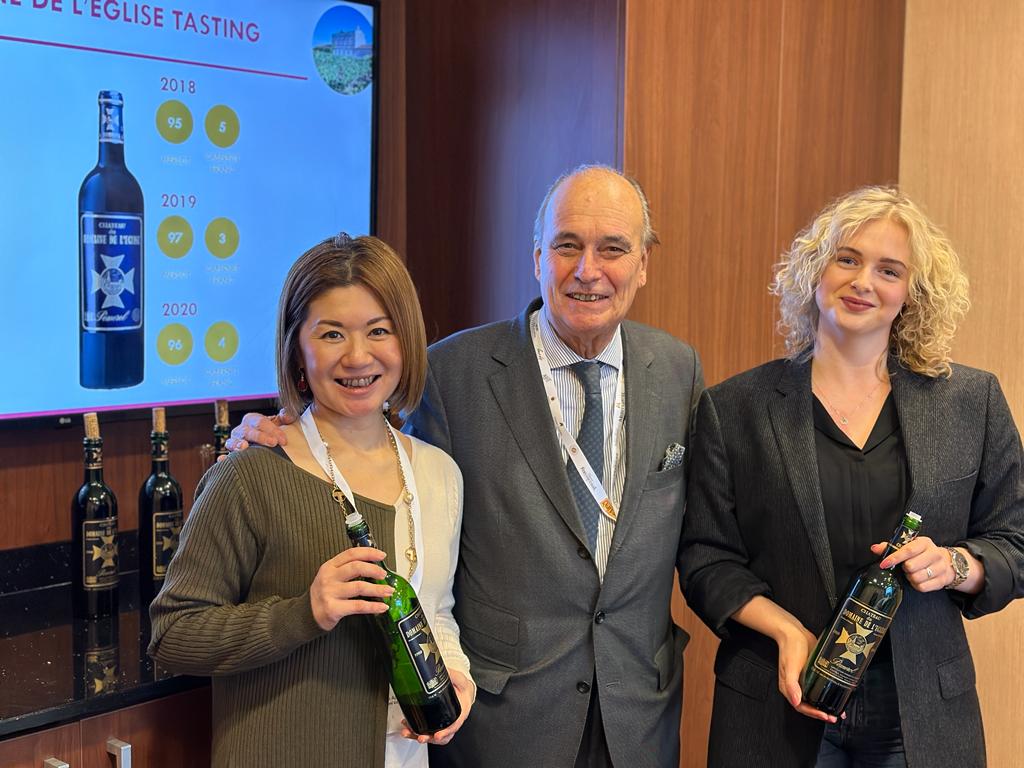At the Heart of Bordeaux’s Prestige: A Masterclass Experience.
In an exceptional showcase of tradition and innovation, two iconic Bordeaux wineries, Château Batailley and Château du Domaine de l’Église, invited us to delve into their storied pasts and vibrant present. Both estates are pillars of the esteemed Borie-Manoux Group and under the stewardship of the Castéja Family since 1932, headed up by Mr. Philippe E. Castéja.
This masterclass was organized and hosted by Dutch importer Poot Agenturen.
The Guardian of Heritage: Mr. Philippe E. Castéja
Since 2001, Mr. Philippe E. Castéja has served as a masterful guide and engaging storyteller at Borie-Manoux, intertwining the rich history and innovative techniques that have shaped Bordeaux’s wine industry. His leadership not only highlights his role as a steward of the company’s legacy but also as a visionary in adopting advanced wine-making practices.
The roots of Borie-Manoux trace back to the 19th century, founded by Eugène Borie (1862-1911) as a wine trading entity. The post-war era saw Marcel Borie (1892-1961), Eugène’s son, take the reins, renaming it Borie-Manoux. Together with his brother Francis (1890-1958), they expanded their vineyard holdings, acquiring several esteemed châteaux.
Parallelly, the Castéja family, influential in Bordeaux since the 17th century, made significant contributions to the wine landscape, notably acquiring Duhart-Milon in the 1830s and Lynch-Moussas in 1919.
In 1961, leadership transitioned to Émile Castéja, Marcel’s son-in-law, who continued to grow the portfolio, adding Châteaux du Domaine de l’Église and Pignon in 1973. Mr. Philippe E. Castéja, continuing his family’s legacy, took charge in the 1990s, further enriching Borie-Manoux’s heritage with strategic acquisitions and leading the company into a new era of technological advancement and collaboration with esteemed winegrowers. His tenure saw the introduction of modern vineyard management and winemaking techniques, under the guidance of renowned consultants Denis Dubourdieu and Valerie Lavigne, marking a significant shift towards excellence.
Under Philippe’s direction, Borie-Manoux has not only preserved its storied heritage but also embraced innovation, ensuring its place at the forefront of Bordeaux’s wine industry. His tenure as the head of the CIVB (Le Conseil Interprofessionnel du Vin de Bordeaux) in the 1990s further underscores his influence and dedication to the region’s wine community. Currently, his son Frédéric joins him, promising to continue this legacy of innovation and excellence at Borie-Manoux.
The Evocative Vintages of Château Batailley and Château du Domaine de l’Église
In the extraordinary masterclass, featuring Château Batailley and Château du Domaine de l’Église, we journeyed through time, tasting a series of vintages that spoke volumes of the estates’ heritage and the evolution of winemaking under the watchful eye of Mr. Philippe E. Castéja.

Château Batailley: A Testament to Pauillac’s Elegance
The tasting commenced with Château Batailley, a fifth growth in Pauillac, embodying the quintessential style of the region. The name “Batailley,” meaning “battle,” harks back to the tumultuous Hundred Years’ War, which raged around the chateau’s vineyards in the year 1453. Situated on the southernmost gravelly plateau of Pauillac, near the border of St-Julien, its style often echoes the elegance of its neighboring appellation. The deep gravel soils here are perfect for cultivating Cabernet Sauvignon, which dominates the estate’s 62 hectares of vineyards, comprising 70% of the plantings. Merlot, Cabernet Franc, and Petit Verdot make up the remainder, contributing to the complexity and depth of Batailley’s wines.
Diving into the Depths of Time: 1988-1989-1990
Our exploration began with the ‘Old Great Vintages’ from Château Batailley. The 1988 vintage enchanted us with its complex blend of dry leaves, tobacco, dried fruits, and a distinct bell pepper aroma, thanks to the rare inclusion of Cabernet Franc. Its resilience against the colder, wetter conditions of the year was rewarded with a 93-point DWA score.
The 1989 vintage, a product of a notably warm year, displayed a robust structure, integrating acidity, tannins, and alcohol with finesse. The palate was a dance of cassis, blackcurrant, mint, spices, and coffee, adorned with a touch of iron— a hallmark of Pauillac’s terroir—earning it a 95-point DWA score.
The 1990 vintage continued this legacy, blending the warmth of the year with a softer texture. The balance of vibrant and dried fruits, alongside notes of graphite, coffee, and leather, culminated in a long finish, meriting a 94-point DWA score.
Witnessing the Promise of Youth: 2018-2019-2020
The ‘Young Great Vintages’ hinted at a bright future. The 2018 vintage stood out with its intense ripe fruit notes of cassis, plum, and green bell pepper, structured by vibrant acidity and chalky tannins, and was rewarded with a 95-point DWA score.
The 2019 vintage offered a glimpse into its potential with a tightly knit profile of black fruits, sweet spices, and smokey notes, structured by supple tannins and high acidity, receiving a 94-point DWA score.
Lastly, the 2020 vintage, bursting with aromas of blackcurrant, black plum, and mint, showcased subtle oak influences and polished tannins. Its bright acidity hinted at a promising future, earning a 94-point DWA score.

Château du Domaine de l’Eglise: Pomerol’s Oldest Gem
Our journey continued at Château du Domaine de l’Eglise, located in Pomerol, Bordeaux. Being the oldest estate of Pomerol, established in 1589, Château du Domaine de l’Eglise is situated in the center of Pomerol on the right bank of the Bordeaux region.
Back in the days, the Domaine was owned by the Foundation of the Hospitaliers and the Church. All estates, including Château du Domaine de l’Eglise, were acquired by Emile Castéja in 1973. Originally, the name of the Domaine was Domaine de l’Eglise, which means “from the church”. For marketing purposes, the name of the Domaine was extended to Château du Domaine de l’Eglise in the 70s, since “Château” was more appealing in the USA.
The vineyard is located near Château Petrus and is in the shade of the bell tower of Pomerol. The soil of the vineyards mostly consists of clay and gravel resulting in grapes of exceptional quality and character. On the 7 hectares of vineyard the average age of the vines comes to the impressive age of 45 years old.
As is typical for the right bank, the wines are predominantly made from Merlot with a small percentage of Cabernet Franc in order to add freshness at the end of the wine and to break the fullness of the Merlot, as Castéja explained. Grapes are hand-harvested at optimal ripeness per plot, then carefully sorted and gently pressed to extract the purest expression of fruit.
A Reflection on Past Splendors: 1988-1989-1990
The ‘Old Great Vintages’ at Château du Domaine de l’Église displayed the estate’s prowess. The 1988 vintage captivated us with its soft, round, and juicy palate, interwoven with tones of dry leaves, forest, tobacco, and mushrooms, and was rewarded with a 97-point DWA score.
The 1989 vintage, from a warmer year, remained reserved yet revealed a deeper fruitiness and notes of mushrooms, demonstrating the classic Pomerol structure and earning a 95- point DWA score.
The 1990 vintage impressed with its balanced, fuller body and complex palate of dry leaves, tobacco, forest, leather, and mushrooms, achieving a 94-point DWA score.
Embracing the Vibrancy of Youth: 2018-2019-2020
The ‘Young Great Vintages’ showcased the estate’s future potential. The 2018 vintage, with its ruby red hue, displayed notes of red cherry, bay leaves, cinnamon, and plum, indicating superior quality with a 93-point DWA score.
The 2019 vintage, warmer and riper, revealed black fruit, cherries, and chocolate, balanced by young tannins and high acidity, and received a 92-point DWA score.
The 2020 vintage presented fruity tones of cassis, cherry, and berries, with more pronounced tannins, suggesting a structure that promises to evolve, earning a 90-point DWA score.

The Enduring Legacy of Bordeaux
The masterclass was a testament to the enduring legacy and vibrant future of Bordeaux winemaking. Each vintage from Château Batailley and Château du Domaine de l’Église offered a unique narrative, blending the richness of history with the promise of innovation. Mr. Philippe E. Castéja’s stewardship has not only preserved the essence of these storied estates but also paved the way for their evolution, ensuring that each glass is a celebration of Bordeaux’s unmatched terroir and winemaking excellence.
The Convergence of Tradition and Innovation
The masterclass not only illuminated the meticulous care in vineyard management and winemaking but also offered a window into the strategic decisions shaping the future of these estates. The nuanced use of Cabernet Franc, the careful selection of barrels, and the adaptability to climate change exemplify the dynamic interplay between tradition and innovation.
Mr. Philippe E. Castéja’s profound connection to the land and his forward-looking vision left us with a deeper appreciation for the intricacies of Bordeaux winemaking. Through these masterclasses, Château Batailley and Château du Domaine de l’Église stand as beacons of excellence, bridging the past and the future of winemaking in Bordeaux.
As we reflect on this enriching experience, it is clear that the essence of Bordeaux—its land, its people, and its traditions—continues to inspire and captivate wine enthusiasts and professionals alike. The dedication to excellence, the embrace of innovation, and the reverence for history at these estates are a testament to the enduring legacy and vibrant future of Bordeaux wines.
We would like to thank Mr. Philippe E. Castéja for his wonderful stories and the excellent masterclass. On top of that we thank Poot Agenturen, importer for Château Batailley and Château du Domaine de l’Église, for organizing this masterclass and inviting us.
The wines mentioned are available through selected partners of Poot Agenturen in retail and hospitality. This article is written by our own Kazumi Uejo and Marlon Rouw.

